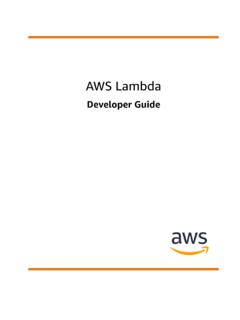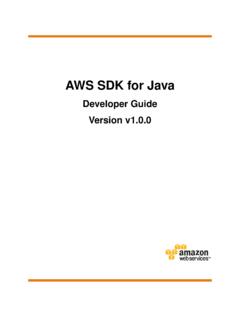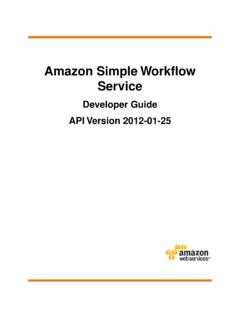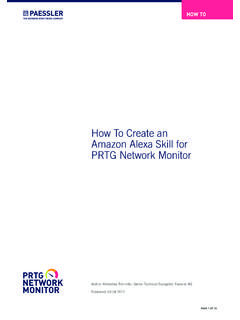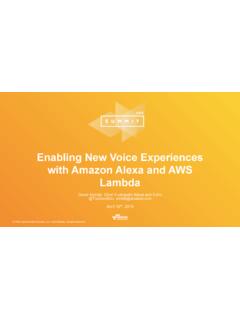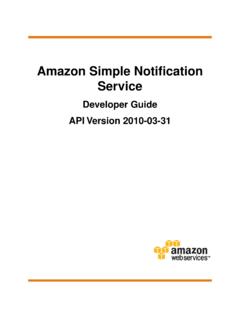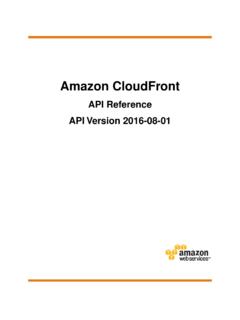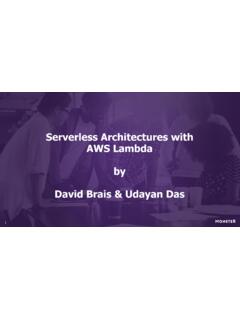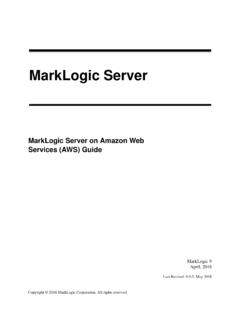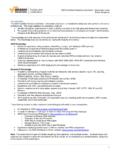Transcription of Peter Sbarski - Amazon Web Services
1 MANNINGP eter Sbarski FOREWORDS BY Patrick DeboisDonald F. FergusonSAMPLE CHAPTERS erverless Architectures in AWSby Peter SbarskiChapter 1 Copyright 2017 Manning Publicationsviibrief contentsPART 1 FIRST 11 Going serverless 32 Architectures and patterns 163 Building a serverless application 394 Setting up your cloud 66 PART 2 CORE 955 Authentication and authorization 976 lambda the orchestrator 1337 API Gateway 168 PART 3 GROWING YOUR 1998 Storage 2019 Database 22710 Going the last mile 260 Part 1 First stepsYou re now taking the first steps toward mastery of
2 Serverless first part of this book takes you through the concepts and introduces you tothe five principles of serverless architectures. You ll learn about several usefuldesigns and architectures, and you ll begin building your own media-transcodingpipeline using lambda , S3, and the Elastic Transcoder. Beginning with the thirdchapter and continuing thereafter, you ll find fun exercises to try in your sparetime. These exercises are optional but highly recommended, because they llreinforce your knowledge and understanding of serverless technologies serverlessIf you ask software developers what software architecture is, you might get answersranging from it s a blueprint or a plan to a conceptual model to the big pic-ture.
3 It s undoubtedly true that architecture, or lack thereof, can make or breaksoftware. Good architecture may help to scale a web or mobile application, andpoor architecture may cause serious issues that necessitate a costly rewrite. Under-standing the implication of choice regarding architecture and being able to planahead is paramount to creating effective, high-performing, and ultimately success-ful software systems. This book is about how to go beyond traditional back-end architectures thatrequire you to interact with a server in some shape or form.
4 It describes how to createThis chapter covers Traditional system and application architectures Key characteristics of serverless architectures and their benefits How serverless architectures and microservices fit into the picture Considerations when transitioning from server to serverless4 CHAPTER 1 Going serverlessserverless back ends that rely entirely on a compute service such as Amazon Web Services (AWS) lambda and an assortment of useful third-party APIs, Services , and products. Itshows how to build the next generation of systems that can scale and handle demand-ing computational requirements without having to provision or manage a single , this book describes techniques that can help developers quickly deliverproducts to market while maintaining a high level of quality and performance by usingservices and architectures that today s cloud has to offer.
5 The first chapter of this book is about why we think serverless is a game changerfor software developers and solution architects. This chapter introduces key servicessuch as AWS lambda and describes the principles of serverless architecture to helpyou understand what makes a true serverless system. we got to where we areIf you look at systems powering most of today s web-enabled software, you ll see back-end servers performing various forms of computation and client-side front ends pro-viding an interface for users to operate via their browser, mobile, or desktop device.
6 In a typical web application, the server accepts HTTP requests from the front endand processes requests. Data might travel through numerous application layersbefore being saved to a database. The back end, finally, generates a response itcould be in the form of JSON or fully rendered markup which is sent back to the cli-ent (figure ). Naturally, most systems are more complex once elements such asload balancing, transactions, clustering, caching, messaging, and data redundancyare taken into account. Most of this software requires servers running in data centersor in the cloud that need to be managed, maintained, patched, and backed up.
7 Provisioning, managing, and patching of servers is a time-consuming task thatoften requires dedicated operations people. A non-trivial environment is hard to setup and operate effectively. Infrastructure and hardware are necessary components ofany IT system, but they re often also a distraction from what should be the corefocus solving the business problem. Over the past few years, technologies such as platform as a service (PaaS) and contain-ers have appeared as potential solutions to the headache of inconsistent infrastructureWhat s in a name?
8 Before we start, we should mention that the word serverless is a bit of a you use a compute service such as AWS lambda to execute your code, orinteract with an API, there are still servers running in the background. The differenceis that these servers are hidden from you. There s no infrastructure for you to thinkabout and no way to tweak the underlying operating system. Someone else takescare of the nitty-gritty details of infrastructure management, freeing your time forother things. Serverless is about running code in a compute service and interactingwith Services and APIs to get the job we got to where we areenvironments, conflicts, and server management overheard.
9 PaaS is a form of cloudcomputing that provides a platform for users to run their software while hiding someof the underlying infrastructure. To make effective use of PaaS, developers need towrite software that targets the features and capabilities of the platform. Moving a legacyapplication designed to run on a standalone server to a PaaS service often leads toadditional development effort because of the ephemeral nature of most PaaS imple-mentations. Still, given a choice, many developers would understandably choose to usePaaS rather than more traditional, more manual solutions thanks to reduced mainte-nance and platform support requirements.
10 Containerization is a way of isolating an application with its own environment. It sa lightweight alternative to full-blown virtualization. Containers are isolated and light-weight but they need to be deployed to a server whether in a public or private cloudor onsite. They re an excellent solution when dependencies are in play, but they havetheir own housekeeping challenges and complexities. They re not as easy as beingable to run code directly in the cloud. Finally, we make our way to lambda , which is a compute service from Amazon WebServices.





